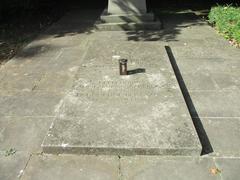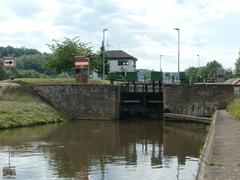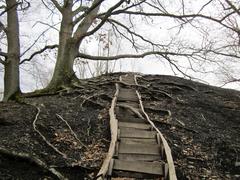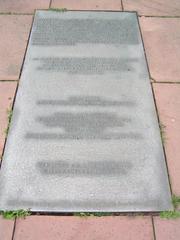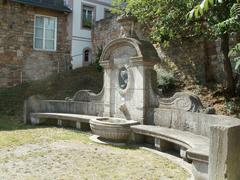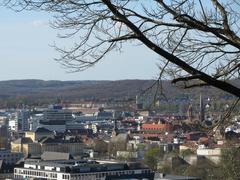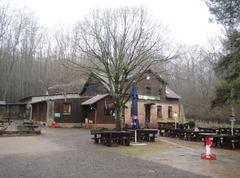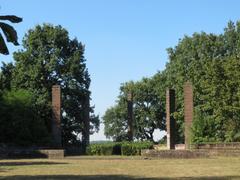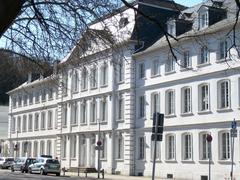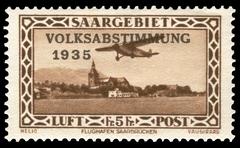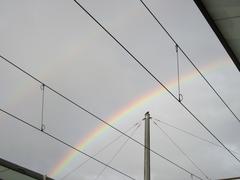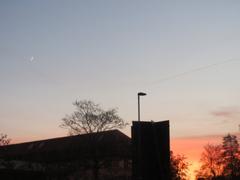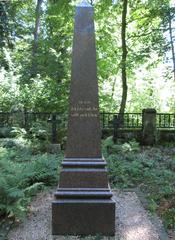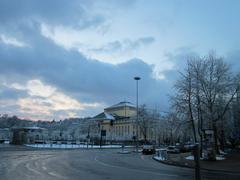
Bunker WH 316 Saarbrücken: Visiting Hours, Tickets, and Historical Guide
Date: 03/07/2025
Introduction
Bunker WH 316 in Saarbrücken, Germany, is a remarkable historical monument that encapsulates the complex military and civilian experiences of the 20th century. Constructed as part of the Westwall (Siegfried Line) during World War II, and later adapted during the Cold War, it stands today as one of the best-preserved bunkers in the region and a powerful symbol of remembrance. This guide presents a comprehensive overview of its history, practical visitor information, and insights into its cultural significance.
(Saarbrücker Zeitung) (Verein Westwall Saar)
Table of Contents
- Introduction
- Historical Background
- Cold War Adaptation: Bunker WH 316 as a Civil Defense Shelter
- Visitor Information
- Visitor Experience and Facilities
- Safety, Conduct, and Accessibility
- Nearby Attractions and Additional Resources
- Frequently Asked Questions (FAQ)
- Conclusion and Practical Tips
- Sources and Further Reading
Historical Background
Construction and Strategic Purpose
Built in autumn 1939 at the end of Brebacher Straße An der Rotschanz, Bunker WH 316 was an integral part of Nazi Germany’s Westwall, a 630-kilometer defensive line designed to repel French attacks. Its location in the Halberg district allowed it to control vital access routes, including Stummstraße, and secure Saarbrücken’s eastern approaches. The bunker was classified as a Regelbau 108b, a standard-type fortification featuring robust defensive capabilities.
(Saarbrücker Zeitung)
Architectural Features
WH 316 is characterized by reinforced concrete walls up to two meters thick and massive steel doors, offering significant protection against artillery and air raids. The bunker’s interior includes crew quarters, combat positions, storage rooms, and hand-cranked ventilation systems, engineered for independent operation even during power outages.
(reisen-ist-freiheit.com)
Life Inside the Bunker
The bunker was typically manned by a 12-person crew, who lived and worked in cramped conditions, always alert for enemy action. Machine gun emplacements, ammunition storage, and rudimentary living quarters highlight the spartan, high-tension atmosphere that defined daily life for its garrison.
Civilian Use and Impact
During air raids, WH 316 also served as a refuge for local civilians and industrial workers, underscoring its dual military and humanitarian role within the Saarbrücken community. Its function as a civilian shelter is a poignant reminder of the shared vulnerability and resilience experienced during wartime.
Postwar Legacy and Preservation
After World War II, Bunker WH 316 remained largely intact, surviving decades of neglect before being restored by local preservation societies. It is now protected as a state monument, offering educational tours and exhibits to foster remembrance and historical understanding.
(Fördergruppe Bunker WH 316 e.V.)
Cold War Adaptation: Bunker WH 316 as a Civil Defense Shelter
In the 1960s, during the height of Cold War tensions, Bunker WH 316 was adapted as a civil protection shelter capable of housing up to 1,800 people for a month in the event of nuclear or conventional attack. Located beneath the A6 motorway in Saarbrücken-Güdingen, the bunker was outfitted with independent power supplies, advanced air filtration, sanitation facilities, medical supplies, and food and water storage.
Restoration efforts by the “Unterirdisches Saarland” association have preserved these Cold War features, and the site now operates as a museum, offering a vivid portrayal of civil defense strategies during this era.
(SR.de)
Visitor Information
Visiting Hours and Tickets
-
World War II Bunker (Halberg-Stellung):
- Open from April to October, Saturdays and Sundays, 11:00 to 17:00.
- Entry typically costs around 5 EUR for adults; discounts available for children and groups.
- Special events and open days are organized throughout the year.
(deutschbranchenbuch.com)
-
Cold War Bunker (Güdingen location):
- Guided tours are available by appointment only.
- Bookings must be made in advance through the Unterirdisches Saarland Facebook page.
- Ticket prices and group discounts are listed on the organizer’s website.
Guided Tours and Booking
All visits are by guided tour, which provides detailed historical commentary and access to restricted areas. Tours are usually offered in German, with English tours available upon request for groups. It is strongly recommended to book in advance due to limited group sizes and irregular opening days.
Accessibility
The historical structure of Bunker WH 316 features narrow corridors, steep steps, and uneven surfaces, which severely restrict accessibility for wheelchair users and those with limited mobility. Contact the site operators in advance to discuss specific needs.
Location and Getting There
-
Halberg-Stellung (WWII Bunker):
- Located in Saarbrücken’s Halberg district (66130 Saarbrücken, Germany).
- Easily accessible via bus lines 111 and 132; parking is available nearby, though limited.
- For navigation, enter “Bunker WH 316, Saarbrücken-Brebach.”
-
Güdingen (Cold War Bunker):
- Located beneath the A6 motorway; detailed directions are provided upon booking.
(reisen-ist-freiheit.com), (Freizeitinsider)
Visitor Experience and Facilities
-
Atmosphere:
Visitors can expect a stark, immersive environment that authentically reflects both the World War II and Cold War periods. The original and reconstructed equipment, dimly lit corridors, and thick concrete walls evoke a sense of tension and reflection. -
Facilities:
- No public restrooms on site; plan accordingly.
- Photography is generally permitted for personal use, with flash and tripods restricted.
- Restored exhibits include weapons, ventilation systems, communication equipment, and period artifacts.
- An interactive map and high-quality visuals are available on the official websites.
-
Comfort:
The bunker remains cool year-round. Sturdy shoes and a light jacket are recommended.
Safety, Conduct, and Accessibility
-
Safety:
The site is well maintained, but visitors must follow all guide instructions for their safety and the preservation of the monument. -
Conduct:
As a site of historical remembrance, respectful behavior is expected. Group sizes are kept small for safety and quality, and children should be supervised at all times. -
Accessibility:
Due to the bunker’s historic architecture, accessibility is limited. Contact organizers for special accommodations.
Nearby Attractions and Additional Resources
Extend your visit by exploring other Saarbrücken heritage sites:
- Saarbrücken Castle and museum
- Saarland Museum
- The Old Bridge (Alte Brücke)
- Ludwigskirche
For more historical sites and visitor tips, see Saarbrücken Tourismus.
Frequently Asked Questions (FAQ)
Q: What are the visiting hours for Bunker WH 316?
A: Open weekends and public holidays (April–October) for WWII site; Cold War bunker tours are by appointment.
Q: How do I book tickets?
A: For WWII site, tickets can be purchased on-site or booked via the Förderverein. For the Cold War site, book tours via Unterirdisches Saarland Facebook page.
Q: Is the bunker accessible for people with disabilities?
A: Due to narrow corridors and steps, accessibility is limited. Contact the organizers for details.
Q: Are tours available in English?
A: Primarily in German, but English tours may be arranged with advance notice.
Q: Can I take photographs?
A: Personal-use photography is allowed; check with guides for any restrictions.
Q: What should I wear?
A: Sturdy, closed-toe shoes and a light jacket.
Conclusion and Practical Tips
Bunker WH 316 is a unique destination that immerses visitors in the layered history of Saarbrücken—from its role in World War II defenses and civilian protection to its Cold War transformation into a civil defense shelter. Managed and preserved by dedicated local associations, the site offers guided tours, educational exhibits, and a powerful atmosphere of remembrance. Due to limited accessibility and irregular opening hours, advance booking is essential. Enhance your visit by exploring Saarbrücken’s other historical landmarks and using the Audiala app for additional content and interactive guides.
Sources and Further Reading
- Saarbrücker Zeitung
- Verein Westwall Saar official website
- reisen-ist-freiheit.com
- deutschbranchenbuch.com
- Fördergruppe Bunker WH 316 e.V.
- SR.de
- Freizeitinsider
- Saarbrücken Tourismus








